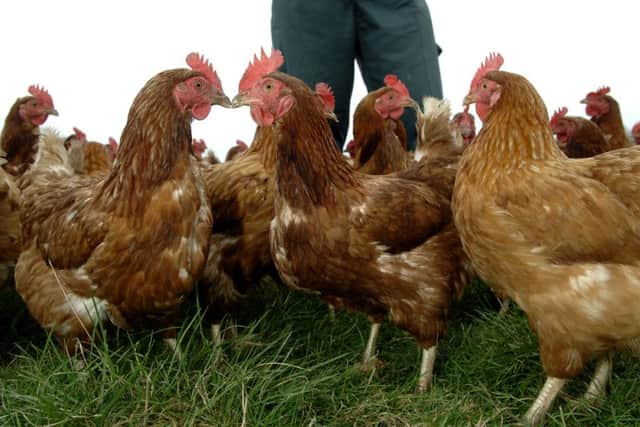45,000 chickens facing slaughter in confirmed bird flu case


A 1km temporary control zone has been set up around the premises in Fife where as many as 40,000 birds could be killed to try to contain the disease.
Experts confirmed last night that a “very mild strain” of H5N1 avian influenza virus had been found at Craigies Poultry Farm in Dunfermline.
Advertisement
Hide AdAdvertisement
Hide AdThe risk to human health is considered “very low”, according to Health Protection Scotland.
Chief Veterinary Officer Sheila Voas said: “All the evidence so far suggests we are dealing with a very mild form of H5N1 avian influenza, which is not the same as the strain that has been causing problems in Asia and north Africa. Further tests are currently being carried out to confirm this but, in the meantime, we are taking no chances.
“As a precaution to prevent the spread of disease - and in line with our robust procedures for dealing with avian flu - we have already put in place movement restrictions around the farm and all birds on the premises will be humanely culled. Consumers should not be concerned about eating eggs or poultry given the expert advice about food safety and human health.
“We are looking into possible sources of this infection in Scotland but it is normal for such viruses to circulate among wild bird populations, especially waterfowl. However, it is important that poultry keepers remain vigilant for any signs of disease and to ensure they are maintaining good biosecurity on their premises.”
• READ MORE: 170,000 chickens culled to stop bird flu outbreak
Officials from the UK government department for environment, food and rural affairs closed the premises off to the public yesterday.
Workers in blue contamination suits were seen putting up yellow warning tape – printed with the words ‘No entry: animal disease control precautions’ – and used disinfectant on their clothing before entering the site.
Officials donned breathing apparatus and full protective gear before entering one of the farm’s five huge chicken sheds.
Advertisement
Hide AdAdvertisement
Hide AdCurbs have been imposed on bird gatherings and the movement of poultry, carcasses, eggs, used litter and manure within the control zone.
The infected farm is thought to be involved with egg production, rather than poultry.
First Minister Nicola Sturgeon said: “We’re taking all appropriate precautionary steps. The early view is that this is a low-pathogenic, low-severity strain.
“Nevertheless, there will be a humane cull of the birds in question. “But it’s important to stress that the risk to human health is very, very low indeed.”
Avian influenza is an infectious virus that spreads among birds, and in rare cases can affect humans. So far no humans have been infected in the UK.
• READ MORE: Scientists raise fresh bird flu pandemic fears
The designation of low or highly pathogenic avian flu refers to the potential for the viruses to kill domestic poultry, not how infectious they may be to humans.
However, low pathogenic strains can mutate to become extremely contagious, causing severe illness and often death in poultry.
The virus can spread to people through direct contact with infected birds and their droppings or secretions, but not via cooked food.
Advertisement
Hide AdAdvertisement
Hide AdRita Botto, head veterinarian of Food Standard Scotland, said: “On the basis of current scientific evidence, Food Standards Scotland’s advice is that bird flu does not pose a food safety risk for UK consumers.”
Scotland produced 90,000 tonnes of chicken valued at over £99 million in 2012, while egg production was estimated to be worth in excess of £43 million. Andrew McCornick, NFU Scotland’s vice president, described the latest outbreak as “worrying but not unexpected”.
There have been a number of cases of avian influenza across continental Europe in recent months, including three cases in other parts of the UK in 2015. In 2006 the village of Cellardyke in Fife reported the first instance of avian flu in the UK after a dead swan, infected with the virus, was found floating in the harbour. No further cases were detected.
As part of routine wildlife disease surveillance, post-mortem examinations of birds are undertaken in incidents where five birds are simultaneously found dead in the same location.